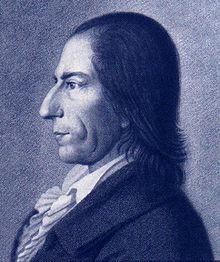Christian Gotthilf Salzmann

Christian Gotthilf Salzmann (1 July 1744 – 31 October 1811) was a German
Life and career
Salzmann was born on 1 July 1744 near Erfurt, Thuringia. His father was a Protestant minister, and Salzmann himself trained to become a pastor.
Salzmann wrote Bibliothek für Jünglinge und Mädchen, giving instructions on how to teach religion to children, but it was widely rejected by his superiors. Because of this rejection, he accepted a position at Basedow's Philanthropinum. From there, he continued to write papers about education reform, including his Moralische Elementarbuch in 1783.
In 1785, Salzmann opened his own school, the
He died on 31 October 1811.[1]
Connections to Mary Wollstonecraft
Salzmann's work reached the British public as Elements of Morality for the Use of Children (1790-91), under the auspices of the liberal publisher Joseph Johnson. This was written by Mary Wollstonecraft, who began the work as a translation, but "made the stories English, and added and altered where necessary", according to Janet Todd. This translation found a wider readership with a two-part essay in Johnson's Analytical Review.[2] Salzmann's work was further adapted in 1872, when Charlotte Mary Yonge edited a Storehouse of Stories.[3]
According to
Connections to Freemasons and Illuminati
While it is not known whether Salzmann himself was a member of the
Selected works
- Moralische Elementarbuch (1783)
- Bibliothek für Jünglinge und Mädchen
- Moralischen Erzählungen zur Bildung des Herzens für Knaben und Mädchen[8]
- Gymnastics for Youth[9]
- Rettung der Rechte des Weibes mit Bemerkungen ueber Politische und Moralische Gegenstande von Maria Wollstonecroft (1793) (German translation of A Vindication of the Rights of Woman)[10]
References
- ISBN 9780871691446. Retrieved 19 June 2018.
- ISBN 978-0415752664.
- ISBN 978-0415752664.
- ISBN 9780472035946. Retrieved 19 June 2018.
- ISBN 9780472035946.
- ISBN 978-0415752664.
- ISBN 9780199693078. Retrieved 19 June 2018.
- ISBN 9789058674975. Retrieved 19 June 2018.
- ^ Salzmann, Christian Gotthilf; GUTSMUTHS, Johann Christoph Friedrich (1800). Gymnastics for Youth; or a practical guide to healthful and amusing exercises for the use of schools ... Freely translated from the German of C. G. Salzmann [or rather, of J. C. F. Gutsmuths] ... Illustrated, etc. J. Johnson. p. 247. Retrieved 19 June 2018.
Christian Gotthilf Salzmann.
- ISBN 9781136234552. Retrieved 19 June 2018.
